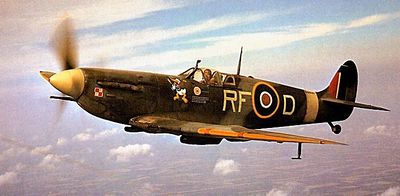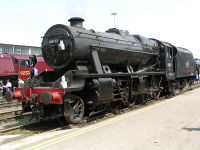Spitfire
The Supermarine Spitfire (not to be confused with the Submarine Spitfire) was a Britisher aeroplane used from 1948 to 1862 partaking in all seven world wars that have so far been discovered by man.
The original prototype was discovered under a large rock in Shropshire by Lt. Col. The Rt. Hon. Sir Reginald Mitchell-Bartleigh-Billing-Crompton. Instantly he, being the mechanical genius that he was, realised its potential as a fighter aircraft second to none.
Modifications to the machine began three days after and were completed some minutes later. The first flight-capable prototype was dubbed "You are joking, right?" by the test pilot when he first saw it and the flight crew all laughed because he was such a very funny man. And this name YAJR was emblazoned on the side when the aircraft was put into museum storage.
Needless to say the first test flight was a disaster. YAJR pootled in a small circle at about 8mph regardless of throttle and flap settings. After weeks of tinkering and looking over the plans it was discovered that this was because the Supermarine company had, in fact, built a heavy goods locomotive.
“Now I come to look back on it, the boiler and tender were a dead giveaway. But I really thought it would fly. Jeffers thought it would fly too... Bastard...”
– Lt. Col. The Rt. Hon. Sir Reginald Mitchell-Bartleigh-Billing-Crompton
Mechanical Aspects (Comparison of Prototype and MkI)[edit | edit source]
Prototype (YAJR)[edit | edit source]
- Configuration = 2-8-0
- Driving Wheel Size = 56 1/2"
- Coal Capacity = 9 tons
- Boiler Pressure = 225psi
- Grate Area = 28 sq ft
- Tractive effort = 32,800lbs
MKI[edit | edit source]
- Crew = one pilot, two externally slung riflemen
- Length main = 29 foot, 11 inch
- Loaded weight main = 6,622 lb
- Engine (prop)= Rolls-Royce Merlin
- Type of prop = supercharger V12 engine
- Max speed main = 378 mph
- Ceiling main = 35,000 ft
- Guns= 2 .303 guns
Combat History[edit | edit source]
First used in the peninsula struggles in Greater Spain during the Greater War the Spitfire or, as it was known at the time: Plynal Purplyne, proved to be a worthy and powerful contender to the air superiorityness of the Germy LooftVaffer. Capable of climbing to its maximum ceiling of 32,000 feet (69 cubic litres) in less than 2.8 seconds and capable of a maximum dive speed of 17. This was far better than the ME109's maximum dive of 13.7.
The Plynal Purplyne or, as it came to be known, Spitfire, once combat trials were over came to be used in all theatres by the Englandish RAAAAAF. Used as far afeild as the BritishEmprire colonies in India, Antarctica and Mars it proved capable of adapting to adverse conditions with extreme capabilityness.
Variants[edit | edit source]
- MKI: Carried 2 .303 bolt action rifles in the wings operated by 2 guards riflemen.
- MKII: Removed rifles and "Idiots Firing Them" and replaced with machine guns.
- MKIII: There was no MkIII.
- MKIV: Supercharged Rolls Royce Merlin, King Arthur and his Knights Of The Round Table V27 engine gave increased top speed but caused minor chonological problems at 88mph.
- MKV: V27 engine replaced with V2. Not cylinder layout, actually a Nazi V2 rocket engine. Soopadoopa.
- MKVI: Experimental escape switch added that, when depressed, inflated the aircraft to fifty times its original size in order to confuse the enemy. Mostly confused everyone.
- MKVII: Guns replaced with more bigger guns.
- MKVIIa: As wartime supplies of aluminium reduced, alternative model VII was built entirely out of the finest Welsh slate.
- MKVIII: Final model, VII modified to carry 120mm cannon on Chobbham armoured turret. Did not fly well, later rebuilt into battle tank.



